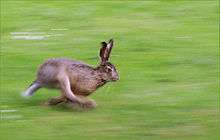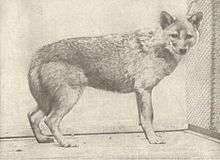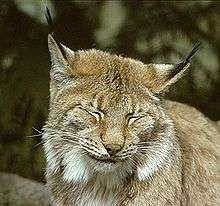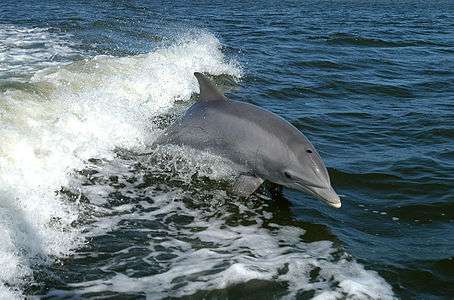List of mammals of Europe
This is a list of European mammals. It includes all mammals currently found in Europe (from northeast Atlantic to Ural Mountains and northern slope of Caucasus Mountains), whether resident or as regular migrants. Moreover, species occurring in Cyprus, Canary Islands (Spain) and Azores (Portugal) are listed here. If geographical range of given European mammal additionally overlaps Turkey, it is noted in some of cases. This checklist does not include species found only in captivity or extinct in Europe, except where there is some doubt about this. Each species is listed, with its binomial name and notes on its distribution where this is limited. Introduced species are also noted.

Summary of 2006 IUCN Red List categories.
Conservation status - IUCN Red List of Threatened Species:
- EX - extinct, EW - extinct in the wild
- CR - critically endangered, EN - endangered VU - vulnerable
- NT - near threatened, LC - least concern
- DD - data deficient, NE - not evaluated
- (v. 2013.2, the data is current as of March 5, 2014[1])
Eulipotyphlans
Erinaceidae
- Hedgehogs
- European hedgehog, Erinaceus europaeus LC
- Southern white-breasted hedgehog, Erinaceus concolor LC
- Northern white-breasted hedgehog, Erinaceus roumanicus LC
- Long-eared hedgehog, Hemiechinus auritus LC (eastern Europe)
Talpidae
- Moles
- European mole, Talpa europaea LC
- Mediterranean mole, Talpa caeca LC (south of the Alps)
- Roman mole, Talpa romana LC (Italy and Greece)
- Balkan mole, Talpa stankovici LC (Balkans)
- Spanish mole, Talpa occidentalis LC (Iberian Peninsula)
- Levant mole, Talpa levantis LC (south-eastern Europe )
- Desmans
- Pyrenean desman, Galemys pyrenaicus VU (Spain, Portugal and the Pyrenees)
- Russian desman, Desmana moschata VU (Russia)
Soricidae (shrews)
- Common shrew, Sorex araneus LC
- Crowned shrew, Sorex coronatus LC
- Iberian shrew, Sorex granarius LC
- Apennine shrew, Sorex samniticus LC
- Eurasian pygmy shrew, Sorex minutus LC
- Laxmann's shrew, Sorex caecutiens LC
- Eurasian least shrew, Sorex minutissimus LC
- Taiga shrew, Sorex isodon LC
- Alpine shrew, Sorex alpinus NT
- Udine shrew, Sorex arunchi DD (Italy, Slovenia)
- Valais shrew, Sorex antinorii DD (formerly in Sorex araneus, Italy, France, Switzerland)
- Eurasian water shrew, Neomys fodiens LC
- Mediterranean water shrew, Neomys anomalus LC
- Etruscan shrew, Suncus etruscus LC
- Greater white-toothed shrew, Crocidura russula LC
- Lesser white-toothed shrew, Crocidura suaveolens LC
- Bicoloured shrew, Crocidura leucodon LC
- Gueldenstaedt's shrew, Crocidura gueldenstaedtii
- Sicilian shrew, Crocidura sicula LC (Sicily, Malta)
- North African white-toothed shrew, Crocidura pachyura LC (Mediterranean islands)
- Cretan shrew, Crocidura zimmermanni VU (Crete)
- Canarian shrew, Crocidura canariensis EN (Canary Islands in Africa - Spain)
Primates
- Human, Homo sapiens sapiens (H. sapiens: LC)
- Barbary macaque, Macaca sylvanus EN (Gibraltar - United Kingdom)
Bats
Pteropodidae (megabat)
- Egyptian fruit bat, Rousettus aegyptiacus LC (Cyprus)
Rhinolophidae (horseshoe bats)
- Lesser horseshoe bat, Rhinolophus hipposideros LC
- Greater horseshoe bat, Rhinolophus ferrumequinum LC
- Mediterranean horseshoe bat, Rhinolophus euryale NT
- Blasius's horseshoe bat, Rhinolophus blasii LC
- Mehely's horseshoe bat, Rhinolophus mehelyi VU
Vespertilionidae (evening bats)
- Daubenton's bat, Myotis daubentonii LC
- Nathalina bat, Myotis (daubentonii) nathalinae (Myotis daubentonii: LC)
- Long-fingered bat, Myotis capaccinii VU
- Pond bat, Myotis dasycneme NT
- Brandt's bat, Myotis brandtii LC
- Whiskered bat, Myotis mystacinus LC
- Steppe whiskered bat, Myotis aurascens LC (formerly in Myotis mystacinus, south-eastern and eastern Europe)
- Alcathoe bat, Myotis alcathoe DD (Greece, Hungary)
- Geoffroy's bat, Myotis emarginatus LC
- Natterer's bat, Myotis nattereri LC
- Cryptic myotis, Myotis crypticus
- Escalera's bat, Myotis escalerai LC (Spain, Portugal, France)
- Bechstein's bat, Myotis bechsteinii NT
- Greater mouse-eared bat, Myotis myotis LC
- Lesser mouse-eared bat, Myotis blythii LC
- Felten's myotis, Myotis punicus NT (Corsica, Sardinia, Malta)
- Common noctule, Nyctalus noctula LC
- Lesser noctule, Nyctalus leisleri LC
- Azores noctule, Nyctalus azoreum EN (the only mammal species endemic to North Atlantic Azores archipelago - Portugal)
- Greater noctule, Nyctalus lasiopterus NT
- Serotine, Eptesicus serotinus LC
- Meridional serotine, Eptesicus (serotinus) isabellinus LC
- Northern bat, Eptesicus nilssonii LC
- Botta's serotine, Eptesicus bottae LC (east Aegean Islands in Greece)
- Eptesicus lobatus DD (Ukraine)
- Parti-coloured bat, Vespertilio murinus LC
- Common pipistrelle, Pipistrellus pipistrellus LC
- Soprano pipistrelle, Pipistrellus pygmaeus LC
- Nathusius's pipistrelle, Pipistrellus nathusii LC
- Kuhl's pipistrelle, Pipistrellus kuhlii LC
- Savi's pipistrelle, Pipistrellus savii LC
- Dusky pipistrelle, Pipistrellus hesperidus LC (Canary Islands in Africa - Spain)[2][n 1]
- Common long-eared bat, Plecotus auritus LC
- Grey long-eared bat, Plecotus austriacus LC
- Madeira pipistrelle, Pipistrellus maderensis EN (Canary Islands and Madeira in Africa - Spain, Portugal)
- Kolombatovic's long-eared bat, Plecotus kolombatovici LC (Mediterranean)
- Alpine long-eared bat, Plecotus macrobullaris LC (mountains of southern Europe)
- Sardinian long-eared bat, Plecotus sardus VU (Sardinia)
- Canary big-eared bat, Plecotus teneriffae EN (Canary Islands in Africa - Spain)
- Barbastelle, Barbastella barbastellus NT
Miniopteridae
- Schreibers' bat, Miniopterus schreibersii NT
Molossidae (free-tailed bats)
- European free-tailed bat, Tadarida teniotis LC (southern Europe)
Nycteridae (slit-faced bats)
- Egyptian slit-faced bat, Nycteris thebaica LC
Lagomorphs

Leporidae (leporids)
- European rabbit, Oryctolagus cuniculus NT
- European hare, Lepus europaeus LC
- Mountain hare, Lepus timidus LC
- Granada hare, Lepus granatensis LC (Spain, Portugal)
- Broom hare, Lepus castroviejoi VU (Cantabrian Mountains)
- Corsican hare, Lepus corsicanus VU (Corsica, southern Italy)
- Cape hare, Lepus capensis LC (Corsica, Cyprus in Asia - Greece, Turkey)
Rodents
Sciuridae (squirrels)
- Red squirrel, Sciurus vulgaris LC
- Siberian flying squirrel, Pteromys volans LC (northern Scandinavia, Estonia)
- European souslik, Spermophilus citellus VU (north-eastern Europe)
- Yellow ground squirrel, Spermophilus fulvus LC (eastern Europe)
- Little ground squirrel, Spermophilus pygmaeus LC (eastern Europe)
- Caucasian squirrel, Sciurus anomalus LC (eastern Europe)
- Spotted souslik, Spermophilus suslicus NT (south-eastern Europe)
- Alpine marmot, Marmota marmota LC (Alps, Tatras, Carpathians, Pyrenees and Balkans)
- Bobak marmot, Marmota bobak LC (eastern Europe)
- Siberian chipmunk, Eutamias sibiricus LC (Netherlands, Belgium and Germany)
Castoridae
- European beaver, Castor fiber LC (Scandinavia, Estonia, Russia, France, Netherlands and Germany)
Hystricidae (Old World porcupines)
- Crested porcupine, Hystrix cristata LC (Italy, introduced )
Gliridae (dormice)
- Garden dormouse, Eliomys quercinus NT
- Forest dormouse, Dryomys nitedula LC (eastern Europe)
- Woolly dormouse, Dryomys laniger DD (Turkey)
- Edible dormouse, Glis glis LC
- Hazel dormouse, Muscardinus avellanarius LC
- Roach's mouse-tailed dormouse, Myomimus roachi VU (Greece and Bulgaria)
Muroids::Spalacidae (spalacids)
- Greater mole rat, Spalax microphthalmus LC (eastern Europe)
- Lesser mole rat, Spalax leucodon DD (eastern Europe)
- Podolsk mole rat, Spalax zemni VU (eastern Europe)
- Sandy mole-rat, Spalax arenarius EN (eastern Europe)
- Balkan mole rat, Spalax graecus NT
- Nehring's blind mole rat, Spalax nehringi DD (may occur in Greece)
Muroids::Cricetidae
- Hamsters
- Common hamster, Cricetus cricetus LC (eastern Europe)
- Gray dwarf hamster, Cricetulus migratorius LC (Balkans)
- Romanian hamster, Mesocricetus newtoni NT (shores of the Black Sea)
- Lemmings
- Wood lemming, Myopus schisticolor LC (Scandinavia)
- Norway lemming, Lemmus lemmus LC (northern Europe)
- Arctic lemming, Dicrostonyx torquatus LC (Svalbard as migrant)
- Voles
- Bank vole, Myodes glareolus LC
- Northern red-backed vole, Myodes rutilus LC
- Grey red-backed vole, Myodes rufocanus LC
- Balkan snow vole, Dinaromys bogdanovi VU
- European water vole, Arvicola amphibius LC
- Montane water vole, Arvicola scherman LC
- Southwestern water vole, Arvicola sapidus VU (Spain and France)
- Field vole, Microtus agrestis LC
- Common vole, Microtus arvalis LC
- Sibling vole, Microtus epiroticus (M. levis: LC)
- Root vole, Microtus oeconomus LC
- Snow vole, Microtus nivalis LC
- Gunther's vole, Microtus guentheri LC
- Cabrera's vole, Microtus cabrerae NT
- Bavarian pine vole, Microtus bavaricus CR
- European pine vole, Microtus subterraneus LC
- East European vole, Microtus levis LC
- Social vole, Microtus socialis LC
- Felten's vole, Microtus felteni DD
- Gerbe's vole, Microtus gerbei LC
- Savi's pine vole, Microtus savii LC
- Calabria pine vole, Microtus brachycercus LC (formerly in Microtus savii, Italy)
- Alpine pine vole, Microtus multiplex LC
- Tatra pine vole, Microtus tatricus LC
- Liechtenstein's pine vole, Microtus liechtensteini LC
- Mediterranean pine vole, Microtus duodecimcostatus LC
- Lusitanian pine vole, Microtus lusitanicus LC
- Thomas's pine vole, Microtus thomasi LC
- Major's pine vole, Microtus majori LC
- Steppe lemming, Lagurus lagurus LC
- Northern mole vole, Ellobius talpinus LC
Muroids::Muridae
- Old World rats and mice
- Wood mouse, Apodemus sylvaticus LC
- Steppe field mouse, Apodemus witherbyi LC (eastern Europe)
- Yellow-necked mouse, Apodemus flavicollis LC
- Black Sea field mouse, Apodemus ponticus LC (Caucasus)
- Alpine field mouse, Apodemus alpicola LC (Alps)
- Pygmy field mouse, Apodemus uralensis LC (eastern Europe)
- Broad-toothed field mouse, Apodemus mystacinus LC (south-eastern Europe)
- Western broad-toothed field mouse, Apodemus epimelas LC (Balkans)
- Striped field mouse, Apodemus agrarius LC (eastern Europe)
- Eurasian harvest mouse, Micromys minutus LC
- House mouse, Mus musculus LC
- Algerian mouse, Mus spretus LC (France, Spain and Portugal)
- Steppe mouse, Mus spicilegus LC (south-eastern Europe)
- Cypriot mouse, Mus cypriacus LC (Cyprus)
- Macedonian mouse, Mus macedonicus LC (south Balcans)
- Spiny mice
- Cretan spiny mouse, Acomys minous DD (Crete)
- Jirds
Muroids::Dipodidae (dipodids)
- Birch mice
- Northern birch mouse, Sicista betulina LC (Scandinavia and north-eastern Europe)
- Southern birch mouse, Sicista subtilis LC (south-eastern Europe)
- Hungarian birch mouse, Sicista (subtilis) trizona EN (Hungary)
- Nordmann’s birch mouse, Sicista loriger VU (eastern Europe)
- Strand's birch mouse, Sicista strandi LC (eastern Europe)
- Severtzov's birch mouse, Sicista severtzovi LC (eastern Europe)
- Jerboas
- Dwarf fat-tailed jerboa, Pygeretmus pumilio LC (eastern Europe)
- Great jerboa, Allactaga major LC (eastern Europe)
- Small five-toed jerboa, Allactaga elater LC (eastern Europe)
- Northern three-toed jerboa, Dipus sagitta LC (eastern Europe)
- Thick-tailed three-toed jerboa, Stylodipus telum LC (eastern Europe)
Carnivorans
Ursidae (bears)
- Polar bear, Ursus maritimus VU (Svalbard, migrant to Iceland and northern Scandinavia)
- Brown bear, Ursus arctos LC
Canidae

- Grey wolf, Canis lupus LC (Spain, Italy, France, Germany, Scandinavia and eastern Europe)
- Golden jackal, Canis aureus LC (Russia and south-eastern Europe)
- Red fox, Vulpes vulpes LC
- Corsac fox, Vulpes corsac LC (Along southern Volga)
- Arctic fox, Alopex lagopus LC (Scandinavia and Iceland)
- Dhole, Cuon alpinus europaeus EN E
Mustelidae (weasel)
- Stoat, Mustela erminea LC
- Least weasel, Mustela nivalis LC
- European mink, Mustela lutreola CR (eastern Europe)
- European polecat, Mustela putorius LC
- Steppe polecat, Mustela eversmanii LC
- Marbled polecat, Vormela peregusna VU (eastern Europe)
- Pine marten, Martes martes LC
- Beech marten, Martes foina LC (southern Europe)
- Sable, Martes zibellina LC (introduced )
- Wolverine, Gulo gulo LC (Scandinavia)
- European otter, Lutra lutra NT
- Eurasian badger, Meles meles LC
Viverridae (viverrids)
- Common genet, Genetta genetta LC (France, Spain, Italy, Portugal)
Felidae (cats)

- Swamp cat, Felis chaus LC (Cis-Caspian region)[4]
- European wildcat, Felis silvestris LC
- Eurasian lynx, Lynx lynx LC
- Iberian lynx, Lynx pardinus EN (southern Spain and Portugal)
- Persian leopard, Panthera pardus tulliana EN (P. pardus: NT) (Dagestan, Northern Caucasus)[5][6]
Phocidae (earless seals)
- Common seal, Phoca vitulina LC
- Ringed seal, Pusa hispida LC (formerly Phoca hispida) (Northern Scandinavia)
- Grey seal, Halichoerus grypus LC (Norway, Baltic. Great Britain and Ireland)
- Mediterranean monk seal, Monachus monachus CR (Mediterranean)
- Harp seal, Pagophilus groenlandicus LC (formerly Phoca groenlandica) (Northern Scandinavia)
- Bearded seal, Erignathus barbatus LC (Northern Scandinavia)
- Hooded seal, Cystophora cristata VU (Northern Scandinavia)
Odd-toed ungulates
Equidae (horse)
- Feral horse, Equus ferus caballus
- Przewalski's horse, Equus ferus przewalskii (Ukraine)[7]
- Feral donkey, Equus africanus asinus (Sardinia)
- Turkmenian kulan, Equus hemionus kulan (Ukraine)[8]
Even-toed ungulates
Bovidae (bovid)
- Feral cattle, Bos primigenius taurus
- European bison, Bison bonasus VU (Eastern Europe, reintroduced)
- Musk ox, Ovibos moschatus LC (Svalbard and northern Scandinavia, reintroduced)
- European mouflon, Ovis orientalis musimon VU (Corsica, Cyprus and Sardinia, introduced elsewhere)
- Alpine ibex, Capra ibex LC (France, Italy, Switzerland and Germany)
- Spanish ibex, Capra pyrenaica LC (Spain and Portugal)
- Wild goat, Capra aegagrus VU (southern Europe and Russia)
- Cretan goat, Capra aegagrus creticus (C. aegagrus: VU) (Crete)
- Feral goat, Capra aegagrus hircus
- Chamois, Rupicapra rupicapra LC
- Pyrenean chamois, Rupicapra pyrenaica LC (mountains of south-west Europe)
- Saiga antelope, Saiga tatarica tatarica CR (S. tatarica: CR) (eastern Europe)
Cervidae (deer)
- Red deer, Cervus elaphus LC
- Fallow deer, Dama dama LC
- Elk, Alces alces LC (Scandinavia)
- Reindeer, Rangifer tarandus LC (Scandinavia)
- Roe deer, Capreolus capreolus LC
Cetacea
Delphinidae (oceanic dolphins)


- Rough-toothed dolphin, Steno bredanensis LC
- Striped dolphin, Stenella coeruleoalba LC (Mediterranean subpopulation: VU)
- Atlantic spotted dolphin, Stenella frontalis DD
- Short-beaked common dolphin, Delphinus delphis LC
(Mediterranean subpopulation: EN, ssp. ponticus: VU) - Bottle-nosed dolphin, Tursiops truncatus LC
(Mediterranean subpopulation: VU, ssp. ponticus: EN) - White-beaked dolphin, Lagenorhynchus albirostris LC
- Atlantic white-sided dolphin, Lagenorhynchus acutus LC
- Fraser's dolphin, Lagenodelphis hosei LC (Canary Islands in Africa)
- False killer whale, Pseudorca crassidens DD
- Killer whale, Orcinus orca DD
- Risso's dolphin, Grampus griseus LC (Mediterranean subpopulation: DD)
- Long-finned pilot whale, Globicephala melas DD (Mediterranean subpopulation: DD)
- Short-finned pilot whale, Globicephala macrorhynchus DD
- Pygmy killer whale, Feresa attenuata DD
Phocoenidae (porpoises)
- Common porpoise, Phocoena phocoena LC
(Baltic Sea subpopulation: CR, ssp. relicta - Black Sea harbour porpoise: EN)
- Common porpoise, Phocoena phocoena LC
Monodontidae
- White whale, Delphinapterus leucas NT (Arctic Ocean)
- Narwhal, Monodon monoceros NT (Arctic Ocean)
Kogiidae
- Pygmy sperm whale, Kogia breviceps DD
- Dwarf sperm whale, Kogia sima DD
Physeteridae
- Sperm whale, Physeter macrocephalus VU (Mediterranean subpopulation: EN)
Ziphiidae (beaked whales)
- Gervais' beaked whale, Mesoplodon europaeus DD
- Blainville's beaked whale, Mesoplodon densirostris DD
- True's beaked whale, Mesoplodon mirus DD
- Sowerby's beaked whale, Mesoplodon bidens DD
- Grays beaked whale, Mesoplodon grayi DD
- Northern bottlenose whale, Hyperoodon ampullatus DD
- Cuvier's beaked whale, Ziphius cavirostris LC (Mediterranean subpopulation: DD)
Balaenopteridae (rorquals)

- Blue whale, Balaenoptera musculus EN (ssp. musculus North Atlantic stock: VU)
- Fin whale, Balaenoptera physalus EN (Mediterranean subpopulation: VU)
- Sei whale, Balaenoptera borealis EN
- Common minke whale, Balaenoptera acutorostrata LC
- Bryde's whale, Balaenoptera edeni DD (Canary Islands in Africa)
- Humpback whale, Megaptera novaeangliae LC
Eschrichtiidae
- North Atlantic gray whale, Eschrichtius robustus EX (possible vagrant from Pacific was recorded in 2010[9])
Balaenidae
- Bowhead whale, Balaena mysticetus LC
(Svalbard-Barents Sea (Spitsbergen) subpopulation: CR) - North Atlantic right whale, Eubalaena glacialis EN
- Bowhead whale, Balaena mysticetus LC
Introduced animals
Macropodidae (macropods)
- Red-necked wallaby, Macropus rufogriseus LC (Britain, France and Germany, introduced)
Erinaceidae
- North African hedgehog, Atelerix algirus LC (France and Spain, probably introduced)
Sciuridae (squirrels)
- Grey squirrel, Sciurus carolinensis LC (Britain, introduced)
- Barbary ground squirrel, Atlantoxerus getulus LC (Canary Islands in Africa - Spain, introduced)
- Siberian chipmunk, Tamias sibiricus LC (introduced)
Myocastoridae
- Coypu, Myocastor coypus LC (introduced)
Muroids::Cricetidae
- Hamsters
- Golden hamster, Mesocricetus auratus VU (introduced)
- Muskrat
- Muskrat, Ondatra zibethicus LC (introduced)
Canidae
- Raccoon dog, Nyctereutes procyonoides LC (introduced)
Mustelidae (weasel)
- American mink, Neovison vison LC (Germany, Belgium, Great Britain and the Netherlands, introduced)
Herpestidae (mongooses)
- Egyptian mongoose, Herpestes ichneumon LC (Spain and Portugal, disputed, possibly native)
Procyonidae
- Common raccoon, Procyon lotor LC (introduced)
- South American coati, Nasua nasua LC (Great Britain, introduced)
Mephitidae
- Striped skunk, Mephitis mephitis LC (introduced)
Camelidae (camels)
- Dromedary camel, Camelus dromedarius LC (Canary Islands, introduced)
Bovidae (bovid)
- Barbary sheep, Ammotragus lervia VU (Spain and Portugal, introduced)
Cervidae (deer)
- Sika deer, Cervus nippon LC (introduced)
- Chital, Axis axis LC (introduced)
- White-tailed deer, Odocoileus virginianus LC (introduced)
- Chinese muntjac, Muntiacus reevesi LC (Britain, Ireland, Japan, Holland, Belgium, introduced)
- Chinese water deer, Hydropotes inermis VU (Britain, France, introduced)
See also
Further reading
- Macdonald D., Barrett P., Collins Field Guide: Mammals of Britain & Europe, HarperCollinsPublishers, London, 1993, ISBN 0-00-219779-0
- Görner M., Hackethal H., Beobachten und bestimmen: Säugetiere Europas, Neumann Verlag, Leipzig, Radebeul, 1987, ISBN 3-7402-0025-1
Notes
- According to the IUCN Red List this distribution needs to be confirmed and bats from North Africa are treated as Pipistrellus kuhlii.[3]
References
- "The IUCN Red List of Threatened Species". International Union for Conservation of Nature and Natural Resources. Retrieved 21 June 2012.
- Simmons, N.B. (2005). "Order Chiroptera". In Wilson, D.E.; Reeder, D.M (eds.). Mammal Species of the World: A Taxonomic and Geographic Reference (3rd ed.). Johns Hopkins University Press. pp. 474–475. ISBN 978-0-8018-8221-0. OCLC 62265494.
- Piraccini, R. 2016. Pipistrellus hesperidus. The IUCN Red List of Threatened Species 2016: e.T136741A22035802. https://dx.doi.org/10.2305/IUCN.UK.2016-2.RLTS.T136741A22035802.en. Downloaded on 06 January 2018.
- Ellerman, J. R. and Morrison-Scott, T. C. S. (1966). Checklist of Palaearctic and Indian mammals 1758 to 1946. Second edition. British Museum of Natural History, London. Pp. 306–307
- WWF (2007) Strategy for the Conservation of the Leopard in the Caucasus Ecoregion. Strategic Planning Workshop on Leopard Conservation in the Caucasus. Tbilisi, Georgia, 30 May – 1 June 2007
- Kitchener, A. C.; Breitenmoser-Würsten, C.; Eizirik, E.; Gentry, A.; Werdelin, L.; Wilting, A.; Yamaguchi, N.; Abramov, A. V.; Christiansen, P.; Driscoll, C.; Duckworth, J. W.; Johnson, W.; Luo, S.-J.; Meijaard, E.; O’Donoghue, P.; Sanderson, J.; Seymour, K.; Bruford, M.; Groves, C.; Hoffmann, M.; Nowell, K.; Timmons, Z.; Tobe, S. (2017). "A revised taxonomy of the Felidae: The final report of the Cat Classification Task Force of the IUCN Cat Specialist Group" (PDF). Cat News (Special Issue 11).
- "The Last Truly Wild Horses Are Alive and Well in Chernobyl". Popular Mechanics. October 17, 2019. Retrieved 16 February 2020.
- "'Mother Nature recovers amazingly fast': reviving Ukraine's rich wetlands". The Guardian. December 27, 2019. Retrieved 6 February 2020.
- King, Anthony (20 August 2015). "Are grey whales climate change's big winners?". The Irish Times.
External links
- Mammal Species of the World, 3rd edition (MSW3) - database of mammalian taxonomy
- Databases: Division of Mammals: Department of Vertebrate Zoology: NMNH
